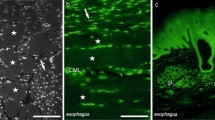Abstract
The number of neurons in the coeliacomesenteric ganglia and the myenteric and submucosal plexuses of the jejunum, ileum and small colon, and the pathological changes induced in them, were studied in various types of equine dysautonomia. In all forms of dysautonomia, severe and extensive neuron loss and damage occurred in the ileum. In acute and subacute dysautonomia, jejunal neuron loss and damage were severe, but in chronic cases significantly less loss or damage occurred. The damage followed the same pattern in the small colon but it was always less obvious than in the jejunum. The distribution of the damage was uniform within a segment of the intestine. In fatal cases of dysautonomia, the clinical severity and duration of illness seems, in most instances, to be related to the amount of neuronal disruption occurring in the jejunum. Severe disruption results in acute/subacute dysautonomia, while milder damage leads to the chronic form.
No case of dysautonomia was encountered in which enteric neuron loss and damage occurred without significant neuronal disruption also occurring in the coeliacomesenteric ganglia.
Ileal neuronal damage and loss are not invariably worse than that in the jejunum, and the possible reasons for this, together with the relationship between neuronal damage and possible causes of dysautonomia, are discussed.
Similar content being viewed by others
Abbreviations
- H&E:
-
haematoxylin and eosin
References
Aherne, W.A. and Dunnill, M.S., 1982.Morphometry, (Edward Arnold, London)
Abercrombie, M., 1946. Estimation of nuclear population from microtome sections.Anatomical Record,94, 239–247
Barlow, R.M., 1969. Neuropathological observations in grass sickness of horses.Journal of Comparative Pathology,79, 407–411
Brownlee, A., 1959. Changes in the coeliaco-mesenteric ganglia of horses affected with grass sickness and horses affected with some other disease.Veterinary Record,71, 668–669
Burns, G.A. and Cummings, J.F., 1991. Equine myenteric plexus with special reference to the pelvic flexure pacemaker.Anatomical Record,230, 417–424
Doxey, D.L., Robb, J., Milne, E.M. and Gilmour, J.S., 1990. Mycological studies on the equine intestinal tract with particular reference to equine dysautonomia (grass sickness).Annals of Applied Biology,117, 337–341
Doxey, D.L., Milne, E.M., Gilmour, J.S. and Pogson, D.M., 1991. Clinical and biochemical features of grass sickness (equine dysautonomia).Equine Veterinary Journal,23, 360–364
Doxey, D.L., Pogson, D.M., Milne, E.M., Gilmour, J.S. and Chisholm, H.K., 1992. Clinical equine dysautonomia and autonomic neurone damage.Research in Veterinary Science,53, 106–109
Doxey, D.L., Pearson, G.T., Milne, E.M., Gilmour, J.S. and Chisholm, H.K., 1995. The equine enteric nervous system — neuron characterization and distribution in adults and juveniles.Veterinary Research Communications,19, 433–449
Gilmour, J.S., 1973a. Experimental reproduction of the neurological lesions associated with grass sickness.Veterinary Record,92, 565–566
Gilmour, J.S., 1973b. Observations on neuronal changes in grass sickness of horses.Research in Veterinary Science,15, 197–200
Greig, J.R., 1942.Grass Sickness in Horses. Reprinted from Transactions of the Highland and Agricultural Society of Scotland, Animal Diseases Research Association, Edinburgh, 1–27
Griffiths, I.R., Smith, S., Doxey, D.L., Whitwell, K. and Love, S., 1994. Evidence that the agent of equine grass sickness may reach neurons by retrograde axonal transport.Veterinary Record,135, 520–523
Hultgren, B.D., 1982. Ileocolonic aganglionosis in white progeny of overo spotted horses.Journal of the American Veterinary Medical Association,180, 289–292
Jubb, K.V.F., Kennedy, P.C. and Palmer, N., 1991.Pathology of Domestic Animals, 4th edn, vol. 1, (Academic Press, London), 293
Obel, A.L., 1955. Studies on grass disease. The morphological picture with special reference to the vegetative nervous system.Journal of Comparative Pathology,65, 334–346
Pearson, G.T., 1994. Structural organisation and neuropeptide distribution in the equine enteric nervous system: an immunohistochemical study using wholemount preparations from the small intestine.Cell and Tissue Research,276, 523–534
Pemberton, A.D., Hodgson, J.G., Gilmour, J.S. and Doxey, D.L., 1990. Characterisation of compounds isolated from the sera of horses with acute grass sickness.Research in Veterinary Science,49, 315–318
Pool, W.A., 1927. Grass disease in horses. Paper presented at the National Veterinary Medical Association, October 15th, (Published as a pamphlet by the Animal Diseases Research Association, Edinburgh)
Pogson, D.M., Doxey, D.L., Gilmour, J.S., Milne, E.M. and Chisholm, H.K., 1992. Autonomic neurone degeneration in equine dysautonomia (grass sickness).Journal of Comparative Pathology,107, 271–283
Sellers, A.F., Lowe, J.E. and Brondum, J., 1979. Motor events in equine large colon.American Journal of Physiology,237, E457–464
Scholes, S.F.E., Vaillant, C., Peacock, P., Edwards, G.B. and Kelly, D.F., 1993. Enteric neuropathy in horses with grass sickness.Veterinary Record,132, 647–651
Schusser, G.F. and White, N.A., 1994. Density of myenteric plexuses and neurons in the large and transverse colon of one-day-old foals.Equine Veterinary Journal,26, 337–339
Tocher, J.F., Brown, W., Tocher, J.W. and Buxton, J.B., 1923. Grass sickness investigation report — all phenomena accounted for by evidence.Veterinary Record,3, 37–45
Uzal, F.A., Robles, C.A. and Olaechea, F.V., 1992. Histopathological changes in the coeliaco-mesenteric ganglia of horses withMal Seco in Argentina.Veterinary Record,130, 244–246
Vonderfecht, S.L., Trommershausen Bowling, A. and Cohen, M., 1983. Congenital intestinal aganglionosis in white foals.Veterinary Pathology,20, 65–70
Woods, F.A. and Gilmour, J.S., 1991. A suspected case of grass sickness in the Falkland Islands.Veterinary Record,128, 359–360
Author information
Authors and Affiliations
Additional information
Deceased. Formerly of the Moredun Research Institute, 408 Gilmerton Road, Edinburgh, EH17 7JH, UK
Rights and permissions
About this article
Cite this article
Doxey, D.L., Milne, E.M., Woodman, M.P. et al. Small intestine and small colon neuropathy in equine dysautonomia (grass sickness). Vet Res Commun 19, 529–543 (1995). https://doi.org/10.1007/BF01839341
Accepted:
Issue Date:
DOI: https://doi.org/10.1007/BF01839341




